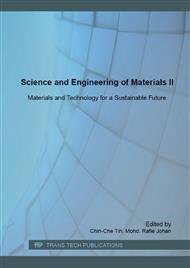p.57
p.67
p.73
p.77
p.83
p.89
p.97
p.101
p.107
Thermal Degradation and Char Morphology of HNTs Reinforced Epoxy Based Intumescent Fire Retardant Coatings
Abstract:
This study investigates the effectiveness of halloysite nanotube as filler on improvement in thermal performance of epoxy based intumescent fire retardant coating. Several intumescent fire retardant formulations were developed with and without halloysite nanotube. The thermal performance and char morphology of Intumescent fire retardant formulations was studied. Bunsen burner (ASTM E-119) test revealed that incorporation of HNTs (1.5 wt. %) improved flame retardancy by reducing the temperature of steel substrate up to 99 °C when exposed to fire for 1 hour. This study also revealed the physical and chemical mechanisms of action of HNTs in the intumescent systems. Results showed that halloysite improved the growth of the intumescent shield and give better quality of char. HNT formed aluminosilicate network for the phosphocarbonaceous structure by chemical contacts with ammonium polyphosphate. These new chemical species enhanced thermal stabilization of the char at high temperature and offered good structural properties on micro and macro scale. This increased the mechanical strength of the shielding layer during burning and also enhanced the residual weight percentage after thermal degradation as shown in thermal gravimetrical curves.
Info:
Periodical:
Pages:
83-88
Citation:
Online since:
July 2016
Price:
Сopyright:
© 2016 Trans Tech Publications Ltd. All Rights Reserved
Share:
Citation:


